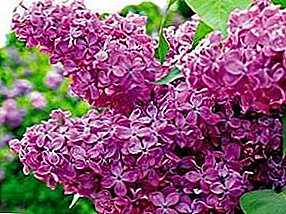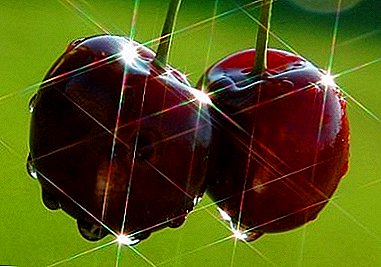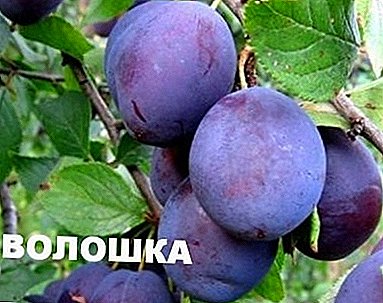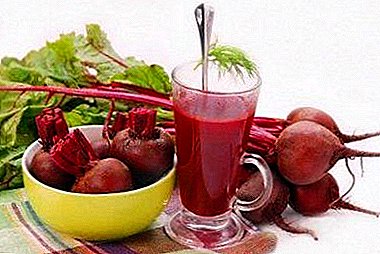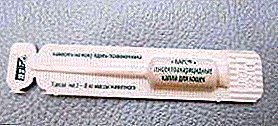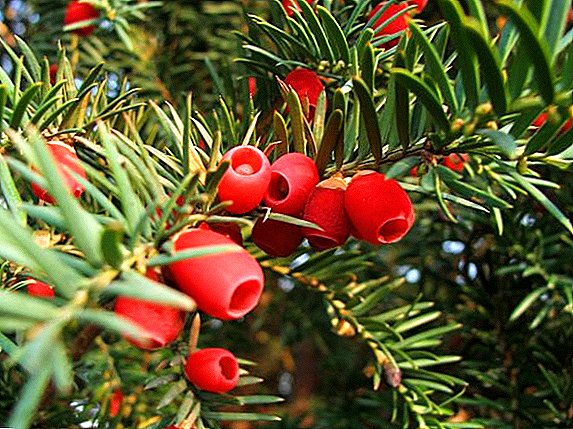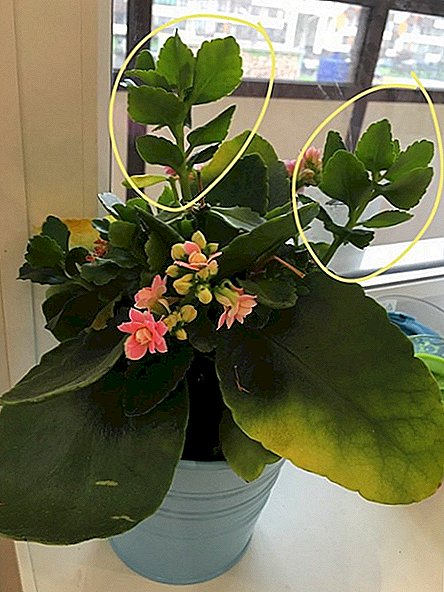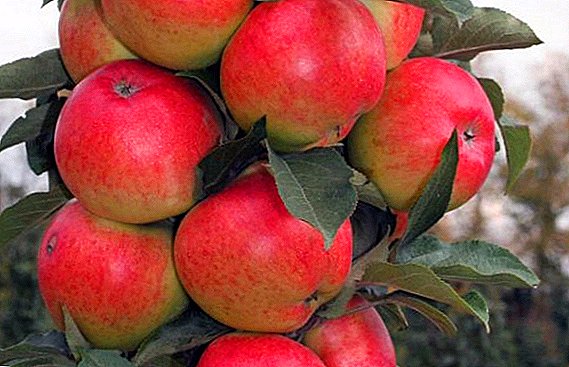 The emergence of columnar apple trees has solved the problem of lack of space in small private plots, allowing gardening and gardening enthusiasts to effectively use the area and collect beautiful harvests from it. Consider the features of one of the best winter varieties and analyze the subtleties of its cultivation.
The emergence of columnar apple trees has solved the problem of lack of space in small private plots, allowing gardening and gardening enthusiasts to effectively use the area and collect beautiful harvests from it. Consider the features of one of the best winter varieties and analyze the subtleties of its cultivation.
Description
Apple "Currency" is a bonsai with a compact dense crown and fruits of medium size, which is main characteristics varieties.
It appeared about 30 years ago at the All-Russian Institute of Horticulture and Nursery. It is based on the genes of the elite species "KV6" and the American "OR38T17".  The tree, despite its short stature, has a high resistance to scab and other bacterial diseases, does not need to be disinfected with toxic chemicals from harmful insects. In addition, the apple tree, surprisingly, gives a huge harvest of winter ripening.
The tree, despite its short stature, has a high resistance to scab and other bacterial diseases, does not need to be disinfected with toxic chemicals from harmful insects. In addition, the apple tree, surprisingly, gives a huge harvest of winter ripening.
Did you know? The pioneer of the columnar fruit trees was a Canadian. In the seventies, he accidentally saw on the old apple tree “Macintosh” a thickened smooth escape without branches, which was thickly hung with fruits. The stalk from this branch was grafted on the stock. Soon a unique tree with a vertical crown grew out of it.
Externally, the apple tree is a thin stem without side skeletal branches up to 2 m high and about 25 cm wide. The crown at all times of the year looks very decorative. Foliage in form and color does not differ from ordinary apple trees, in the fall it does not turn yellow for a long time, keeps to the very frost and drops green. Inflorescences are tied on a shtambe, giving it an elegant look.
 Mature fruits are characterized by a rounded shape, thin skin of golden-yellow color with a delicate scarlet blush, juicy fine-grained pulp of white color.
Mature fruits are characterized by a rounded shape, thin skin of golden-yellow color with a delicate scarlet blush, juicy fine-grained pulp of white color.
On average, Currency varieties weigh about 150–250 g. Above they are covered with a wax coating, under which white subcutaneous specks are clearly visible. Fruit has a pleasant aroma and sweet, sweet-sour taste.
The phase of ripening of the fruits of the apple tree is kolonovidnoy "Currency" occurs in mid autumnThe apples, as mentioned in the description, are intended for winter consumption, are well kept. In the reviews, gardeners note that the fruits do not crumble and are easily accessible for removal from the tree. The breed differs from the usual type of apple trees in undemanding care and ease of planting.
Did you know? Lifespan "Currencies" - up to fifty years, and high yielding is maintained only for a third of this period.
Advantages and disadvantages of the variety
Obviously, compared with tall, spreading apple trees, columnar forms benefit in many ways. Based on the findings of gardeners and professional gardeners, the main positive traits varieties are:
- short stature of trees, which makes it easy to tear off the fruit from them;
- high yield;
- small and decorative apples;
- resistance to frost, pests and diseases;
- good apple keeping quality;
- excellent taste and presentation;
- the versatility of apples (suitable for eating raw and for home canning in all forms);
- simple care (no need for pruning and spraying).
The fact that apples in any form are very useful, everyone knows from childhood. You can save the taste of your favorite fruits for a long time in many ways: freeze, dry, make jam or jam, compote and other goodies.
Among the shortcomings, perhaps, the only quality is a decrease in yield after 15-16 years of life. This forces gardeners to rejuvenate plantings, since on old apple trees from the bottom collar begin to dry out and trees become fruitless. It is not possible to stimulate fruiting by pruning the branches, as on ordinary apples.  On large-scale areas, it is recommended that ten-year-old plants be uprooted, replacing them with new seedlings. Moreover, this procedure is done not immediately throughout the garden, but in parts, in order to avoid a reduction in yield.
On large-scale areas, it is recommended that ten-year-old plants be uprooted, replacing them with new seedlings. Moreover, this procedure is done not immediately throughout the garden, but in parts, in order to avoid a reduction in yield.
Did you know? On average, one standard apple tree produces up to 6 kg of fruits.
How to plant an apple tree
Many people believe that if a tree is undemanding in its care, then planting it is all the same no different from other plants. But it soon turns out that disregard for the rules for choosing a place and rooting seedlings affects the quantity and quality of fruits.
The key to success in gardening, of course, is healthy seedling With a powerful rhizome without any damage. The development of an apple tree during the first ten years depends on its quality, and in the case of columnar specimens this is the period of intensive fruiting.
If you have already acquired a high-quality planting material, and it is a meter-long, straight trunk with an intact root collar, smooth whole bark and a well-developed root system, you can proceed to inspect the landing site. 
Choosing a place for a tree
Apple-tree kolonovidnaya "Currency" prefers to plant a cozy place with a diffused illumination, protected from northern winds and drafts. Not sunshine or shade.
Perfect option - near the fence or the building. It is also important to take into account the location of groundwater: they must be no closer than 2 m from the ground surface, otherwise the excess moisture will spoil the roots, and the plant will die. Look in your garden plot, where a lot of snow accumulates in winter, and in spring there is no stagnant snow water and streams.
Important! Coniferous sawdust is strictly contraindicated as mulch of tree trunks of apple trees, since they tend to oxidize the soil.
Soil selection
Colon-shaped specimens, as well as all apple-trees, develop well on black-soil light soil enriched with useful substances.
When choosing a place, it is necessary to check the acidity of the substrate, since in an acidic environment the tree cannot grow. For full vegetation, he needs good drainage and moderate humidity, therefore, stony and marshy areas are not suitable.
Planting plantation
Given the compactness of miniature crowns of standard trees, they can be planted two ways. The first is to seal the trunks in rows with intervals of 30-40 cm and wide row spacing from 1 to 2.5 m. The second is a square technology when the distance between seedlings in the rows and between the rows is 1 m. 
How to care for the apple "Currency"
Despite the small growth, the tree has a voluminous rhizome, so it takes root quickly and begins to develop. The first 2 months after planting are especially responsible: during this period, the gardener should help the young apple tree with regular soil moistening, dressing, winterizing. Mature plants require much less attention.
Important! During the flowering of standard apple trees, spray them with sugar syrup. This will attract the bees and contribute to one hundred percent pollination of the inflorescences.
Watering a tree
At first, the seedlings of the apple tree are kolonovidnoy "Currency" should be watered with such a frequency that the soil does not dry out, and further cultivation provides for limiting irrigation to 2 times a week.
In the second year of life, apple trees are moistened every 7 days. In large gardens, you can facilitate the process by equipping mechanized irrigation by sprinkling, soil or drip methods. In hot weather, a slight wetting of the substrate will harm the roots more than a drought, so water activities are best done in the morning or evening. The earth should get wet by 30-50 cm.  The amount of water poured under each barrel depends on apple age. Young seedlings need moisture often and little by little, and old trees need the opposite: a lot, but rarely. For example, annual bushes require 3 buckets of water, and five-year buckets require 5 buckets.
The amount of water poured under each barrel depends on apple age. Young seedlings need moisture often and little by little, and old trees need the opposite: a lot, but rarely. For example, annual bushes require 3 buckets of water, and five-year buckets require 5 buckets.
Begin to water the apple orchard before budding. For mature plants, the second moistening is arranged during the formation of the ovary, then - during the period of its growth, the latter - 14 days before the fruits are removed.
In the case when the yard is a long warm autumn, the trees should be watered again. This additional watering protects the roots and sprouts from freezing.
Did you know? Apples in the cellar produce ethylene, which contributes to the intensive ripening of themselves and the surrounding fruits and vegetables. That is why the potatoes that are stored in the same compartment with apples, begins to germinate.
Top dressing and care of the soil
It is desirable to replenish the soil in apple tree trunks with useful substances, preferably throughout the growing season.
In the initial phase, when the shoots begin to grow rapidly, a solution of manure or chicken manure is poured into the recesses previously made in the ground. Organic matter can be replaced with nitrogen-containing commercial mixtures.  When the tree enters the phase of fruiting, it is important to feed from nitroammofoski (30 g), ammonium nitrate (30 g), superphosphate (140 g), potassium chloride (50 g). An alternative to this mixture may be a solution of 100 g of superphosphate, 70 g of potassium sulfate and 10 liters of water.
When the tree enters the phase of fruiting, it is important to feed from nitroammofoski (30 g), ammonium nitrate (30 g), superphosphate (140 g), potassium chloride (50 g). An alternative to this mixture may be a solution of 100 g of superphosphate, 70 g of potassium sulfate and 10 liters of water.
Be careful with feedings. Nitrogen fertilizers are necessary for the tree at the beginning of development, and in the autumn they can only harm, because the grown tree will not have time to prepare for winter and freeze. To stimulate winter hardiness in September, apple trees are fed with mineral complex fertilizers marked “Autumn” on the package or with humus.
The final stage of any irrigation should be loosening and mulching the soil. First, these moments affect the future harvest. And secondly, they feed the root system with oxygen and do not allow moisture to evaporate, prevent the formation of a tight crust on the top layer of the tree trunk circle.
Important! Acidic soils are neutralized every 4 years with lime powder at the rate of 200 g per 1 square meter. For lack of lime, can her replace with old plaster.
Crown formation
There are almost no branches in the crown-shaped apple trees that need to be cut, trimming only needed in the rare cases when the crown begins to form incorrectly.
Often this happens when the upper fruit bud is damaged: then a tree has two tops. The one that is weaker must be cut off. If the stem begins to branch, side shoots are also subject to removal. On fruit shoots annually should be removed by two buds.  Sometimes on the trunks in the first or second year inflorescences are tied. In this case, all the buds are cut off, giving the tree the opportunity to form a powerful crown and, accordingly, the root system. When re-flowering leave about six of the strongest inflorescences, and in the next year - about ten.
Sometimes on the trunks in the first or second year inflorescences are tied. In this case, all the buds are cut off, giving the tree the opportunity to form a powerful crown and, accordingly, the root system. When re-flowering leave about six of the strongest inflorescences, and in the next year - about ten.
Certain varieties of pears, plums, apricots also have a columnar form.
Breeding features
In nurseries, the main method of reproduction of columnar apple trees is budding. But to take the stalks from the trunk is almost impossible, since there are no side branches, and it is impractical to cut the top, which is a continuation of the main trunk. Therefore, for the purpose of blanks for budding, the stubs are severely sheared, which stimulates the branching of the column. As a result, each mother apple has 5-10 sprouts.
At home, gardeners often graft petioles of their favorite columnar varieties onto the branches of ordinary apple trees. In this case, the crown clearly stands out a single branch, generously hung with fruits.
Important! Shtamby grafted on seed stocks, differ in the later periods of fruiting.
Preparing for the winter
Argued that winter varieties of apples do not need special preparation for the cold, because they are vaccinated from their parents genes low temperature endurance.  In fact, this fallacy is completely unfounded. All young saplings, and especially columns, are equally sensitive to the harsh winters, so caring gardeners are obliged to help the plants to overwinter. In the northern regions with very harsh winters for this purpose, apple trees are planted in trenches, which are filled with sawdust and fallen leaves and snow in the fall.
In fact, this fallacy is completely unfounded. All young saplings, and especially columns, are equally sensitive to the harsh winters, so caring gardeners are obliged to help the plants to overwinter. In the northern regions with very harsh winters for this purpose, apple trees are planted in trenches, which are filled with sawdust and fallen leaves and snow in the fall.
In latitudes with a temperate climate, this technique is not practiced, but protects the roots with mulch, and the top is covered with non-woven material. Trunks half wrapped sheet of tar or branches of coniferous crops. This is done so that hungry rodents do not eat the bark. You can scare them off with unpleasant odors, but this method is not as effective as sheltering a column.


